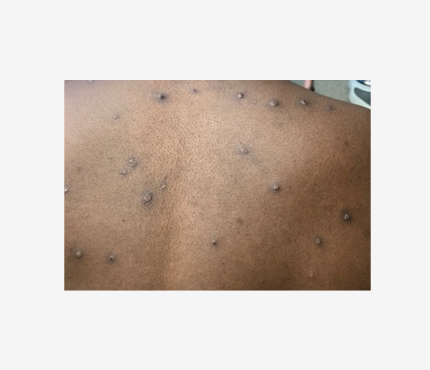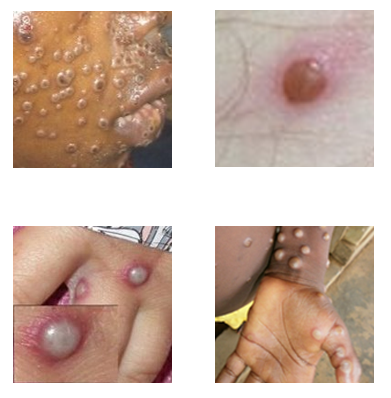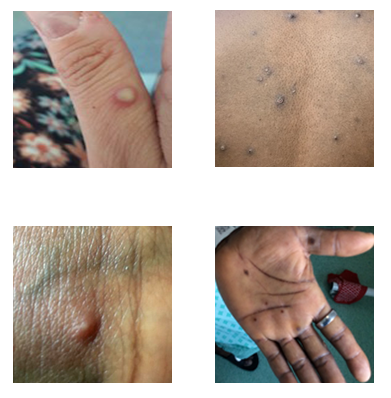Key points
- Regardless of clade, monkeypox lesions present similarly and can be spread and treated the same way.
- Monkeypox lesions can be painful; they're firm or rubbery, well-circumscribed, deep-seated, and often develop umbilication.
- Some patients develop only a few lesions while others have widespread ulcers.
- The evolution of lesions progresses through four stages before scabbing over and desquamation.

Key characteristics

Lesions are firm or rubbery, well-circumscribed, deep-seated, and often develop umbilication (resembles a dot on the top of the lesion).
Lesions are often described as painful until the healing phase when they become itchy (crusts). Fever and other prodromal symptoms (e.g., chills, lymphadenopathy, malaise, myalgias, or headache) can occur before rash but may occur after rash or not be present at all. Respiratory symptoms (e.g. sore throat, nasal congestion, or cough) can occur.
Lesions typically develop simultaneously and evolve together on any given part of the body. The evolution of lesions progresses through four stages—macular, papular, vesicular, to pustular—before scabbing over and desquamation.
The incubation period is 3-17 days. During this time, a person does not have symptoms and may feel fine. Illness typically lasts 2-4 weeks.
The severity of illness can depend upon the initial health of the individual and the route of exposure.
Examples of monkeypox rashes

Current outbreaks
For both clade I and clade II monkeypox virus infection:
- Lesions often occur in the genital and anorectal areas or in the mouth.
- Rash is not always disseminated across many sites on the body.
- Rash may be confined to only a few lesions or only a single lesion.
- Rash does not always appear on palms and soles.
- Rectal symptoms (e.g., purulent or bloody stools, rectal pain, or rectal bleeding) have been frequently reported in the current outbreak.
Disease stages
Monkeypox disease is characterized by an incubation period, prodrome, and rash.

Incubation period
Infection with monkeypox virus begins with an incubation period where the person does not have symptoms and may feel fine. The incubation period is roughly 1-2 weeks. A person is not contagious during this period. Physicians are currently recommended to monitor patients up to 21 days.
Prodrome
People with monkeypox infection may develop an early set of symptoms (prodrome). These symptoms may include fever, malaise, headache, sore throat, or cough, and (in many cases) swollen lymph nodes. Lymphadenopathy is a characteristic feature of monkeypox, and lymph nodes may swell in the neck (submandibular & cervical), armpits (axillary), or groin (inguinal) and can occur on both sides of the body or just one. A person may be contagious during this period. Instruct patients to isolate if they develop symptoms.
Rash
In some recent monkeypox cases, people have presented with a rash without a recognized prodrome. Many of the recent cases have only had localized lesions and have not presented with diffuse rash often seen in figures. People with monkeypox infection develop lesions that typically progress from macules, papules, vesicles, pustules, and then scabs. A person is contagious until after all the scabs on the skin have fallen off and a fresh layer of intact skin has formed underneath. Decisions regarding discontinuation of isolation precautions at a healthcare facility and at home should be made in consultation with the local or state health department.

| Stage | Stage Duration | Characteristics |
|---|---|---|
| Enanthem |
|
|
| Macules | 1−2 days |
|
| Papules | 1−2 days |
|
| Vesicles | 1−2 days |
|
| Pustules | 5−7 days |
|
| Scabs | 7−14 days |
|
*This is a typical timeline, but timeline can vary.
Rash resolved
Pitted scars and/or areas of lighter or darker skin may remain after scabs have fallen off. Once all scabs have fallen off and a fresh layer of skin has formed, a person is no longer contagious.
